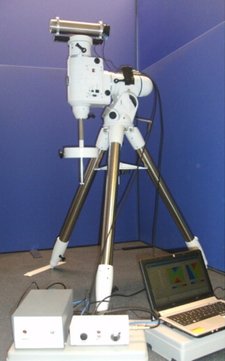Hybrid Instruments Ltd.
Real-Time Analysis
Mixed field imaging
Since unperturbed fast neutrons travel in straight lines until the point at which they are detected, they can be collimated to enable spatial distributions of their intensity (images) to be constructed. This can be done in two ways: the neutron field that reaches a detector can be restricted in space using a neutron absorbing/reflecting material such as a combination of tungsten and polyethylene; or the time of detection can be synchronised in some way, typically with the time of emission of a pulsed source or fission in a fission source.
The Hybrid Instruments Ltd. mixed-field analyser enables neutrons and gamma-rays to be discriminated in real-time so that logic pulses corresponding to both or either can be counted for each position of a number of stages of a scanning collimator.
Hence, separate images corresponding to neutron and gamma-ray distributions are obtained from a single scan enabling sources with different radiation signatures to be separated and, for example, the effectiveness of shielding to be determined for both radiation types. The collimator can be automated and relatively small scanning systems constructed to fit into confined spaces particularly for reactor assessment.
Alternatively the relative time between a gamma-ray event and the associated neutron can be used to determine the position of the emitting source. In this case either a pulsed source (neutron generator) can be used for a deterministic relationship between the primary event and the event that follows or a stochastic assessment i.e. building a probability density distribution for the correlation between fission events, either neutron-neutron, gamma-gamma or mixed event data.
The automated scanning mount and tungsten collimator (left) used to acquire image data and the corresponding event images for gamma rays (a and b)
and neutrons (c and d) for the combination of a 137Cs and 241AmBe sources attached to a concrete wall at 1 m range using the Hybrid MFA (Gamage et al., 2011).
Associated publications
K. A. A. Gamage, J. C. Adams and M. J. Joyce. (2011)
Combined digital imaging of mixed-field radioactivity with a single detector. Nuclear Instruments and Methods in Physics Research Section A (NIM A), Volume 635, Pages 74-77.
M. J. Joyce and K. A. A. Gamage. (2011)
Real-time, digital imaging of neutrons and gamma rays with a fast liquid scintillation detector. IEEE Nuclear Science Symposium, Valencia, Spain, art. 6154120 pp. 602-606.
K. A. A. Gamage, M. J. Joyce and G. C. Taylor. (2012)
A digital approach to neutron-gamma imaging with a narrow tungsten collimator aperture and a fast organic liquid scintillator detector. Appl. Rad. Isot., 70, 1223-1227.
J. S. Beaumont, M. P. Mellor, M. Villa and M. J. Joyce. (2015)
High-intensity power-resolved radiation imaging of an operational nuclear reactor. Nature Communications, DOI: 10.1038/ ncomms9592.


